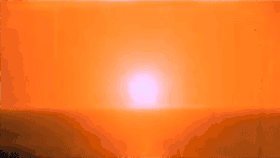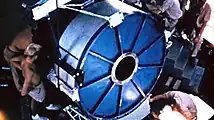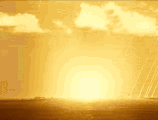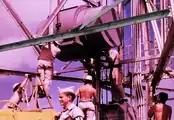Operation Greenhouse
Operation Greenhouse was the fifth American nuclear test series, the second conducted in 1951 and the first to test principles that would lead to developing thermonuclear weapons (hydrogen bombs). Conducted at the new Pacific Proving Ground, on islands of the Enewetak Atoll, it mounted the devices on large steel towers to simulate air bursts. This series of nuclear weapons tests was preceded by Operation Ranger and succeeded by Operation Buster-Jangle.
| Operation Greenhouse | |
|---|---|
 Greenhouse-Item, 45.5-kilotons. | |
| Information | |
| Country | United States |
| Test site |
|
| Period | 1951 |
| Number of tests | 4 |
| Test type | tower |
| Max. yield | 225 kilotonnes of TNT (940 TJ) |
| Test series chronology | |
Operation Greenhouse showcased new and aggressive designs for nuclear weapons. The main idea was to reduce the size, weight, and most importantly, reduce the amount of fissile material necessary for nuclear weapons, while increasing the destructive power. With the Soviet Union's first nuclear test a year and half earlier, the United States had begun stockpiling the new designs before they were actually proven. Thus the success of Operation Greenhouse was vital before the development of thermonuclear weapons could continue.
A number of target buildings, including bunkers, houses and factories were built on Mujinkarikku Islet to test nuclear weapon effects.
George

The George explosion conducted on May 8, 1951 was the world's first thermonuclear burn, though it was just a test design, unsuitable for weaponization. Shaped like a torus, the George device had a small amount of heavy isotopes of liquid hydrogen (deuterium and tritium) placed at its center. The vast majority of its yield derived from fission. The energy output from the thermonuclear fusion in this test was insignificant in comparison. The "George" device was more like a "boosted" nuclear bomb than a thermonuclear one. The small amount of heavy deuterium and tritium in this test fused, but its role was to generate a strong flurry of fast neutrons - ones that sparked more fissions in the uranium nuclei that were present, and which also caused fission in uranium-238 - which does not fission under bombardment with slow neutrons, as does uranium-235.
The George design was a 'Classical Super' prototype with a binary triggering device using radiation implosion upon a cylinder. The design of the triggering system in this test was based on the one patented by Klaus Fuchs and von Neumann in 1946.[1] Its success played a vital role in the history of the Teller–Ulam design. The George Test had a perfect “bell” Wilson cloud formed near the top of the mushroom cloud.
The George test validated the principles which would be used for the first full-scale thermonuclear bomb test, Ivy Mike, one year later, on November 1, 1952, at Enewetak Atoll.
Item
Conducted on May 25, 1951, Item was the first test of an actual boosted fission weapon, nearly doubling the normal yield of a similar non-boosted weapon. In this test, deuterium-tritium (D-T) gas was injected into the enriched uranium core of a nuclear fission bomb. The extreme heat of the fissioning bomb produced thermonuclear fusion reactions within the D-T gas. While not enough to be considered a full nuclear fusion bomb, the large number of high-energy neutrons released nearly doubled the efficiency of the nuclear fission reaction.
Dog photograph
The Dog explosion is more popularly known for an image taken of those viewing it than the actual explosion itself; the photograph depicts numerous VIPs wearing safety goggles sitting on Adirondack chairs while being illuminated by the flash of the detonation.[2][3] This photograph takes up the bottom portion of the cover of the 1995 documentary Trinity and Beyond by Peter Kuran. The safety goggles worn by all those viewing the test in the picture have become somewhat of a museum collectors item, with a possibility that Norman F. Ramsey may have been present.[4] Cynthia Miller claims that her father, Van Dine, is the first man on the left in the photo.[5] The blast wave safely arrived at the location of the VIPs some 45 seconds after the initially silent flash of the detonation as observed from their position on Parry island.[6]
Gallery
 Greenhouse-George, 225-kilotons.
Greenhouse-George, 225-kilotons. George mushroom cloud.
George mushroom cloud. George device being mounted within its shot-tower.
George device being mounted within its shot-tower. Greenhouse-Dog, 81-kilotons.
Greenhouse-Dog, 81-kilotons. Greenhouse-Easy, 47-kilotons.
Greenhouse-Easy, 47-kilotons. Item device being raised upward towards its shot-tower.
Item device being raised upward towards its shot-tower. Item detonation and mushroom cloud.
Item detonation and mushroom cloud.
List
| Name [note 1] | Date time (UT) | Local time zone[note 2][7] | Location[note 3] | Elevation + height [note 4] | Delivery,[note 5] Purpose [note 6] | Device[note 7] | Yield[note 8] | Fallout[note 9] | References | Notes |
|---|---|---|---|---|---|---|---|---|---|---|
| Dog | April 7, 1951 17:33:57.8 | MHT (11 hrs) | Runit (Yvonne), Enewetak Atoll 11.55234°N 162.34648°E | 2 m (6 ft 7 in) + 91 m (299 ft) | tower, weapons development | Mk-6D | 81 kt | [8][9][10][11][12] | Proof test of Mark 6, 60 point implosion. Hansen says "north end of Runit". | |
| Easy | April 20, 1951 17:27:00.1 | MHT (11 hrs) | Enjebi (Janet), Enewetak Atoll 11.66543°N 162.23379°E | 2 m (6 ft 7 in) + 91 m (299 ft) | tower, weapon development and effects | TX-5D | 47 kt | [8][9][10][11][12] | Proof test of Mark 5, 92 point lense implosion system, used as the primary for Ivy Mike. Mock buildings (homes, bunkers, factories) were assembled on Enjebi and Mujinkarikku Island. Hansen: "west end of Engebi". | |
| George | May 8, 1951 20:30:00.7 | MHT (11 hrs) | Ebiriru (Ruby), Enewetak Atoll 11.62703°N 162.29626°E | 2 m (6 ft 7 in) + 62 m (203 ft) | tower, weapons development | "Cylinder" | 225 kt | [8][9][10][11][12] | Deuterium core, proof test of staged thermonuclear design, but most yield from boosted fission. | |
| Item | May 24, 1951 17:16:59.3 | MHT (11 hrs) | Enjebi (Janet), Enewetak Atoll 11.66604°N 162.24254°E | 2 m (6 ft 7 in) + 62 m (203 ft) | tower, weapons development | "Booster" | 45.5 kt | [8][9][11][12] | First tritium boosted test. |
- The US, France and Great Britain have code-named their test events, while the USSR and China did not, and therefore have only test numbers (with some exceptions – Soviet peaceful explosions were named). Word translations into English in parentheses unless the name is a proper noun. A dash followed by a number indicates a member of a salvo event. The US also sometimes named the individual explosions in such a salvo test, which results in "name1 – 1(with name2)". If test is canceled or aborted, then the row data like date and location discloses the intended plans, where known.
- To convert the UT time into standard local, add the number of hours in parentheses to the UT time; for local daylight saving time, add one additional hour. If the result is earlier than 00:00, add 24 hours and subtract 1 from the day; if it is 24:00 or later, subtract 24 hours and add 1 to the day. Historical time zone data obtained from the IANA time zone database.
- Rough place name and a latitude/longitude reference; for rocket-carried tests, the launch location is specified before the detonation location, if known. Some locations are extremely accurate; others (like airdrops and space blasts) may be quite inaccurate. "~" indicates a likely pro-forma rough location, shared with other tests in that same area.
- Elevation is the ground level at the point directly below the explosion relative to sea level; height is the additional distance added or subtracted by tower, balloon, shaft, tunnel, air drop or other contrivance. For rocket bursts the ground level is "N/A". In some cases it is not clear if the height is absolute or relative to ground, for example, Plumbbob/John. No number or units indicates the value is unknown, while "0" means zero. Sorting on this column is by elevation and height added together.
- Atmospheric, airdrop, balloon, gun, cruise missile, rocket, surface, tower, and barge are all disallowed by the Partial Nuclear Test Ban Treaty. Sealed shaft and tunnel are underground, and remained useful under the PTBT. Intentional cratering tests are borderline; they occurred under the treaty, were sometimes protested, and generally overlooked if the test was declared to be a peaceful use.
- Include weapons development, weapon effects, safety test, transport safety test, war, science, joint verification and industrial/peaceful, which may be further broken down.
- Designations for test items where known, "?" indicates some uncertainty about the preceding value, nicknames for particular devices in quotes. This category of information is often not officially disclosed.
- Estimated energy yield in tons, kilotons, and megatons. A ton of TNT equivalent is defined as 4.184 gigajoules (1 gigacalorie).
- Radioactive emission to the atmosphere aside from prompt neutrons, where known. The measured species is only iodine-131 if mentioned, otherwise it is all species. No entry means unknown, probably none if underground and "all" if not; otherwise notation for whether measured on the site only or off the site, where known, and the measured amount of radioactivity released.
See also
References
- "FROM THE HISTORY OF PHYSICS Physics ± Uspekhi 39 (10) 1033 ± 1044 (1996) American and Soviet H-bomb development programmes: historical background. G A Goncharov" (PDF).
- "Atomic Goggles (ca. 1950)". Museum of Radiation and Radioactivity.
- "VIP observers at Operation Greenhouse, April 8, 1951". Brookings. December 15, 2016. Retrieved September 23, 2017.
- "Atomic Goggles ca. 1950".
- "Operation Greenhouse, Bombs Part 7".
- "GREENHOUSE Defense Technical Information Center". Archived from the original on January 7, 2016.
- "Time Zone Historical Database". iana.com. Archived from the original on March 11, 2014. Retrieved March 8, 2014.
- Operation Greenhouse (PDF) (DNA-6043F), Washington, DC: Defense Nuclear Agency, Department of Defense, 1951, archived from the original (PDF) on February 19, 2013, retrieved October 26, 2013
- Sublette, Carey, Nuclear Weapons Archive, retrieved January 6, 2014
- Hansen, Chuck (1995), The Swords of Armageddon, Vol. 8, Sunnyvale, CA: Chukelea Publications, ISBN 978-0-9791915-1-0
- United States Nuclear Tests: July 1945 through September 1992 (PDF) (DOE/NV-209 REV15), Las Vegas, NV: Department of Energy, Nevada Operations Office, December 1, 2000, archived from the original (PDF) on October 12, 2006, retrieved December 18, 2013
- Yang, Xiaoping; North, Robert; Romney, Carl (August 2000), CMR Nuclear Explosion Database (Revision 3), SMDC Monitoring Research
External links
- The short film Operation GREENHOUSE (1951) is available for free viewing and download at the Internet Archive.
- The short film Joint Task Force 3 Presents Operation GREENHOUSE (1951) is available for free viewing and download at the Internet Archive.